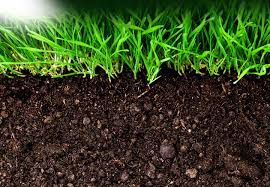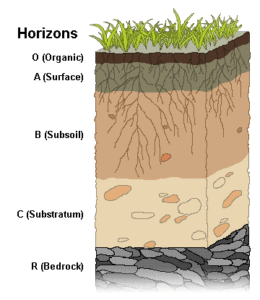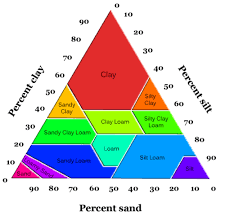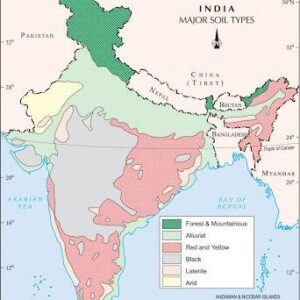LEARNING OBJECTIVES-
-Knowledge about soil and soil formation
– Soil Profile
-Types of soil
-Properties of soil
-Moisture content in the soil
-Absorption of water by soil
-Soil and Crops
Soil erosion and soil conservation-
SOIL-
The natural covering of broken rock particles and humus of the surface of the earth that supports life is called soil. Soil is the outer layer of the earth crust.
Soil supports plants and animals. The sources of food are grown in soil. Fuels, fodder, medicines and fibres are grown in soil. Water for drinking is mainly obtained as underground water. Soil is a habitat for many living organisms like, earthworm, ants, bacteria, fungi, wound worms etc. various kinds of minerals are obtained from the soil like gold, copper, manganese etc.
FORMATION OF SOIL-Soil is a mixture of sand, small rock particles and humus. The sand and small rock particles are formed by physical, chemical and biological weathering of rocks. The humus is formed by humification of dead organic matters. The process of soil formation is called pedogenesis. The study of soil and its properties is called pedology.
Pedogenesis = Weathering of Rocks + Humification
The wind, water, ice, temperature etc help in breaking of rocks. It is physical weathering of rocks. The water, organic acid like carbonic acid formed by decomposition of organic matter, chemical reactions in rocks and acid rain causes the weathering of rock by chemical methods. The animals and roots of plants are the biological agents for causing weathering of rocks.
SOIL PROFILE-
The vertical section of soil which shows differently coloured and textured layers is called soil profile. The chemical composition and depth of different layers of a soil profile also differ from each other. The layers of soil profile are as following-
1. A-Horizon or top soil layer – It is the upper most layer of the soil. It is dark in colour than other layers due to presence of humus (decomposed organic matter). It is soft and porous. It allows water to move inside the soil (water percolation) easily. It is rich in minerals, so plants grow easily. The water holding capacity of this layer is also more due to presence of humus. In this layer various kinds of insects, worms and roots of plants are found in this layer.
2. B-Horizon or Subsoil layer – It is just below the A-horizon. It has very less amount of humus. It is less fertile than A-horizon. It has very less population of microorganisms. It is rich in minerals, harder and compact than top layer. It is slightly light in colour because of more minerals and less humus.
3. C- Horizon – It is just below the B-horizon. It has small rocks formed due to weathering of bedrocks. The roots of trees do not rich to this layer. Very little humus may be found somewhere in it.
4. R-Horizon or Bedrock or Parent rock- The bedrock undergoes weathering to add rocks, sand and minerals to the soil layers. It is very hard and does not allow the water to move down it.
Fig: Soil Profile
TYPES OF SOIL-The size of rock particles are different in different soils. The colour of soil varies according to the presence of minerals and their characteristics. The chemical nature of soil classifies the soil also.
A. SOIL TYPES ON THE BASIS OF PARTICLE SIZE-
Following types of particles are found in the soil.
|
S.N. |
Soil Particle |
Particle size |
|
1 |
Clay |
Less than 0.2 mm |
|
2 |
Silt |
More than 0.2 mm |
|
3 |
Sand |
0.2 – 2.0 mm |
|
4 |
Gravel |
2.0 – 50 mm |
So, soil types are-
1. Sandy soil- The soil which is mainly made up of large sand particles is called sandy soil. Clay and silt may be found very less in such a soil. It is mainly the desert area soil like Thar desert, Rajasthan, Haryana, Gujrat and Punjab. The soil is well aerated due to presence of quite large air-spaces in between soil particles. It has fewer nutrients. Its water holding capacity is less. It can be ploughed easily. It dries easily.
2. Clayey Soil- This soil has very small size clay particles. It smooth and its water holding capacity is very good. The aeration of this soil is not so good. The mineral nutrients are good in this soil. The ploughing of clayey soil is difficult. Sometimes water logging is seen in this soil. Crop like paddy and sugarcane are mainly grown in this soil.
3. Loamy soil- It is one of the best quality of soil for agriculture. It is made up of sand(40%), silt (40%) and Clay (20%). Its water holding capacity is good. It’s minerals content is also optimum. It is suitable for all types of crops but wheat, pulses are mainly grown in this soil.
B. SOIL TYPES ON THE BASIS OF PLACE OF FORMATION
1. Red soil
2. Black Soil
3. Alluvial Soil
4. Laterite soil
5. Mountain Soil
6. Desert Soil
C.SOIL TYPES ON THE BASIS OF CHEMICAL NATURE
1. Acidic soil- pH= 0-7
2. Basic (Alkaline Soil) – pH= 7-14
3. Neutral Soil – pH=7
Properties of Soil-
1. Colour of Soil- The colour of soil is due to mineral contents and organic matters present in it. Red, brown and yellow colours are due to different types of iron oxides in the soil. The black soil is due to certain other minerals, mountain lava and humus present in it.
2. Soil Structure– The soil texture/ structure is different for different kind of soil. Many soils are sticky while others do not stick with each other.
3. Percolation rate- The movement of water down the soil layers is called as percolation or seepage. It helps in recharging the underground water. Sandy soil has more water percolation rate while clayey soil has least water percolation rate.
Percolation rate =Volume of water (in ml.)/Percolation time (in minute)
4. Absorption of water by soil- The water holding / absorption capacity of the soil is different for different soil. It is estimated by the formula as-
Percentage Absorption of water by soil = Volume of water absorbed by the soil/ Weight of soil X 100
5. Moisture content in the soil- The little amount of water adhered to the soil particles is called soil moisture. In summer season, the dry soil has negligible moisture. In rainy season, the soil moisture will be high. When a little amount of soil is warmed in a test-tube, little water vapour can be seen on inner wall of beaker.
Activity 1- To find out the Percolation Rate of soil
Requirements– Clan ground of soil, hollow glass pipe, measuring cylinder, 250 ml water and a Stopwatch.
Procedure-Clean the ground and dig a small hole. Place a glass pipe in that hole and fill it up with soil. Now pour 250 ml of water and start noting down the time take in percolation of water with the help of a stop watch.
Observation– Approximately in 25 minutes 250 ml of water percolated through the soil.
So, we can calculate the percolation rate by the following formula-
Percolation rate =Volume of water (in ml.)/Percolation time (in minute)
= 250 ml/25 minutes
=10 ml/min.
Repeat this activity with sandy and clayey soil also. The sandy soil will have more percolation rate and clayey soil will show comparatively less percolation rate.
Activity 2- To calculate water absorption/water holding capacity of the soil-
Requirements– 100 gm dry powered Soil, a funnel, measuring cylinder, dropper, filter paper, 100 ml water and calibrated conical flask.
Procedure– The filter paper was folded as like a cup and place in the funnel. This was then placed in the mouth of conical flask. The 100 ml water was very slowly poured with the help of dropper.
Observation– The water that came down in the conical flask was 45 ml. It means 55 ml water was absorbed by the dry soil. So, the water absorption capacity of soil was calculated by the formula-
Percentage Absorption of water by soil = Volume of water absorbed by the soil/Weight of soil X 100
=55 ml/100 gm X 100
=55 %
Repeat this activity with sandy and clayey soil also. The sandy soil will have less water holding capacity and clayey soil will show comparatively more water absorption capacity.
Soil and Crops– The crop to be grown in a particular soil depends on the following factors-
a. The type of soil.
b. The climate of that region.
c. The mineral and humus contents of the soil.
1. Sandy Soil- It has low water holding capacity. The humus content is also low. The crops that grow well are wheat and legumes like gram, pea, vegetables, chili etc. Coconut grows in sandy soil of coastal areas.
2. Clayey Soil- Its water holding capacity is maximum. It is well for growing paddy, sugarcane, jute etc.
3. Loamy Soil- Its moderate water holding capacity, optimum humus and minerals content make loamy soil good for almost all type of crops. Paddy, Wheat, Legumes, Vegetables, Cotton, etc. grow well in loamy soil.
Soil Erosion- The top soil is very fertile. The carrying away of fertile topsoil by river water, heavy rain, strong wind, animals etc. from one place to another is called soil erosion. The grasses and roots of trees bind the soil and prevent soil erosion.
Impacts of Soil erosion-
A. Soil erosion causes flood.
B. Soil erosion results into famine.
C. Soil erosion causes landslide in hilly areas.
Causes of soil erosion-
1. Overgrazing
2. Deforestation
3. Excess ploughing of cop fields
Soil erosion can be prevented by-
1.Afforestation- planting of trees on large scale
2. Avoiding overgrazing of cattles
3. Practicing step farming and terrace farming in hilly areas
4. Construction of dams and river embankment
Soil Conservation- The judicious and economic use of soil is called soil conservation. Soil conservation is done to make soil usable for coming generations. Following are the common methods of soil conservation-
1. Afforestation-Plantation of trees on large scale.
2. Contour/Step / Terrace farming in hilly areas.
3. Avoiding overgrazing and excess ploughing of fields.
4. Construction of dams and river embankments.
Soil Pollution– The adding of harmful toxic substances which make the soil unfit for use is called soil pollution. Chemicals like paints, chemical fertilizers, polythene, plastic, salts, radioactive wastes, oil, grease, dye, acids, industrial wastes etc are some harmful substances which harm the soil.
The soil quality, percolation rate, fertility and water holding capacity are affected due to it. Soil pollution can be controlled by following few methods-
- Reducing the excess use of chemical fertilizers and pesticides in crop fields.
- Treatment of industrial wastes before discharging in the soil.
- Throwing of wastes, useless oil, grease, medicines, paints, dyes etc to proper place.
- Avoiding throwing of plastic and polythene
EXERCISE QUESTIONS–
Tick the most suitable answer in questions 1 and 2.
Q.1 In additional to the rock particles, the soil contains-
(i) air and water (ii) water and plants
(iii) minerals, organic matter, air and water
(iv) water, air and plants
Ans-(iii) minerals, organic matter, air and water
Q.2 The water holding capacity is the highest in
(i) sandy soil (ii) clayey soil
(iii) loamy soil (iv) mixture of sand and loam
Ans-(ii) clayey soil
Q.3 Match the items in Column I with those in Column II:
Column I Column II
(i) A home for living organisms (a) Large Particles
(ii) Upper layer of the soil (b) All kinds of soil
(iii) Sandy soil (c) Dark in colour
(iv) Middle layer of the soil (d) Small particles and packed tight
(v) Clayey soil (e) Lesser amount of humus
Ans-(i)-b (ii)-c (iii)-a (iv)-e (v)-d
Q.4 Explain how soil is formed.
Ans- Soil is a mixture of sand, small rock particles and humus. The sand and small rock particles are formed by physical, chemical and biological weathering of rocks. The humus is formed by humification of dead organic matters. The process of soil formation is called pedogenesis.
Pedogenesis = Weathering of Rocks + Humification
The wind, water, ice, temperature etc help in breaking of rocks. It is physical weathering of rocks. The water, organic acid like carbonic acid formed by decomposition of organic matter, chemical reactions in rocks and acid rain causes the weathering of rock by chemical methods. The animals and roots of plants are the biological agents for causing weathering of rocks.
Q.5 How is clayey soil useful for crops?
Ans-Clay soil particles are smooth and its water holding capacity is optimum. The mineral nutrients are good in this soil. Clayey soil is rich in humus content. Due to these reasons, the growths of crops like paddy, sugarcane etc is very good.
Q.6 List the differences between clayey soil and sandy soil.
Ans-

Q.7 Sketch the cross-section of soil and label the various layers.
Ans- The cross section of soil called soil profile is shown in the following labeled diagram-
Q.8 Razia conducted an experiment in the field related to rate of percolation. She observed that it took 40 min. for 200 ml. of water to percolate through the soil sample. Calculate the rate of percolation.
Ans- Given that,
Amount of water=200 ml
Percolation time= 40 minutes
Percolation rate =Volume of water (in ml.)/Percolation time (in minute)
= 200 ml/40 minutes
= 5ml/min.
Q.9 Explain how soil pollution and soil erosion could be prevented.
Ans- Soil pollution can be prevented by-
- Reducing the excess use of chemical fertilizers and pesticides in crop fields.
- Treatment of industrial wastes before discharging in the soil.
- Throwing of wastes, useless oil, grease, medicines, paints, dyes etc to proper place.
- Avoiding throwing of plastic and polythene
Soil erosion can be prevented by-
- Afforestation- planting of trees on large scale
- Avoiding overgrazing of cattles
- Practicing step farming and terrace farming in hilly areas
- Construction of dams and river embankment
Q.10 Solve the following crossword puzzle with the clues given:
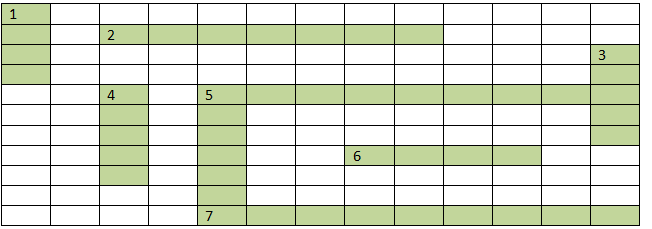
Across
- Plantation prevents it.
- Use should be banned to avoid soil pollution.
- Types of soil used for making pottery.
- Living organism in the soil.
Down
- In desert soil erosion occurs through.
- Clay and loam are suitable for cereals like.
- This type of soil can hold very little water.
- Collective name for layers of soil.
Ans- Across- 2. Erosion 5. Polythene 6. Clay 7. Earthworm
Down- 1. Wind 3. Wheat 4. Sandy 5. Profile
………………XXXXXXXX………………….
Visit You Tube Channel -VKSCIENCE
